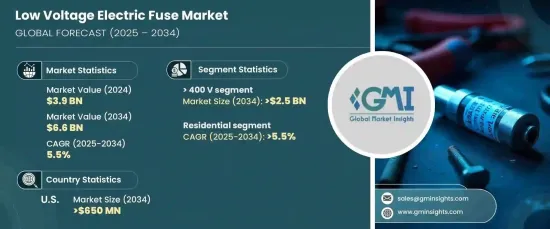
저전압 전기 퓨즈 세계 시장은 2024년 39억 달러로 평가되며 2025년부터 2034년까지 연평균 5.5%의 꾸준한 성장이 예상되며, 2025년부터 2034년까지 5.5%의 CAGR이 예상됩니다.
이러한 성장의 원동력은 다양한 분야의 전기 안전 솔루션에 대한 수요 증가와 특히 신흥 시장에서의 건설 활동의 급증에 기인합니다. 전기 시스템이 더욱 복잡해지고, 특히 전자기기 사용의 증가로 인해 부하가 증가함에 따라 전기적 장애에 대한 신뢰할 수 있는 보호의 필요성이 더욱 중요해지고 있습니다. 또한, 재생에너지 시스템으로의 전환은 가정, 기업 및 산업 시설의 전기 인프라를 보호하는 것의 중요성을 강조하고 있습니다.

400V에서 작동하는 전기 시스템 시장 부문은 2034년까지 25억 달러 규모의 시장을 창출할 것으로 예상됩니다. 전기자동차의 보급과 더불어 급속한 도시화와 개발도상국의 인프라 개발이 진행되면서 저전압 퓨즈를 포함한 고급 전기 부품에 대한 수요가 증가하고 있습니다. 세계 각국 정부는 엄격한 안전 규제를 시행하고 있으며, 이는 주거, 상업 및 산업 프로젝트에서 이러한 퓨즈의 보급을 더욱 촉진하고 있습니다.
| 시장 범위 | |
|---|---|
| 시작 연도 | 2024년 |
| 예측 연도 | 2025-2034년 |
| 시작 금액 | 39억 달러 |
| 예상 금액 | 66억 달러 |
| CAGR | 5.5% |
주택 부문은 2034년까지 5.5%의 CAGR로 강력한 속도로 성장할 것으로 예상됩니다. 신흥국에서는 도시화가 가속화되면서 전기 안전과 전력 시스템 신뢰성에 대한 관심이 높아지고 있습니다. 주택 건설의 증가와 에어컨, 냉장고, TV 등 가전제품의 수요 증가는 주거용 퓨즈 수요를 촉진하는 주요 요인입니다. 또한, 주거용 전기 시스템의 안전성 향상을 위한 정부 규제 또한 시장 확대에 기여하고 있습니다.
미국의 저전압 전기 퓨즈 시장은 2034년까지 6억 5,000만 달러 규모의 시장을 창출할 것으로 예상됩니다. 가전제품의 보급과 주거용 및 상업용 건물 건설과 함께 전기 안전에 대한 관심이 높아지면서 시장 성장을 촉진하고 있습니다. 전기 보호에 투자하는 가정과 기업이 증가함에 따라 IoT에 연결된 스마트 기기의 인기가 높아짐에 따라 신뢰할 수 있는 퓨즈에 대한 수요가 더욱 증가하고 있습니다.
전반적으로, 배전망 개선 노력, 자동차 부문의 확대(특히 전기자동차의 부상), 전력망 인프라 현대화에 대한 지속적인 노력에 힘입어 시장은 지속적인 성장을 이룰 준비가 되어 있습니다. 이러한 요인들은 저전압 전기 퓨즈 시장에 유리한 환경을 조성하고 여러 산업 분야에서 활발한 수요를 확보할 것으로 예상됩니다.
The Global Low Voltage Electric Fuse Market, valued at USD 3.9 billion in 2024, is expected to experience steady growth, with a projected CAGR of 5.5% during 2025-2034. This growth is driven by increasing demand for electrical safety solutions across various sectors, as well as a surge in construction activities, particularly in emerging markets. As electrical systems become more complex and loads increase, particularly due to the rise in electronic device usage, the need for reliable protection against electrical faults has become more critical. Furthermore, the global shift toward renewable energy systems underscores the importance of safeguarding electrical infrastructure in homes, businesses, and industrial facilities.

The market segment for electrical systems operating at 400 V is forecast to generate USD 2.5 billion by 2034. The increasing adoption of electric vehicles, coupled with rapid urbanization and ongoing infrastructure development in developing regions, is driving the demand for advanced electrical components, including low voltage fuses. Governments worldwide are implementing stringent safety regulations, further encouraging the deployment of these fuses in residential, commercial, and industrial projects.
| Market Scope | |
|---|---|
| Start Year | 2024 |
| Forecast Year | 2025-2034 |
| Start Value | $3.9 billion |
| Forecast Value | $6.6 Billion |
| CAGR | 5.5% |
The residential sector is projected to grow at a robust pace, with a CAGR of 5.5% through 2034. As urbanization accelerates in emerging economies, there is a heightened focus on electrical safety and the reliability of power systems. The growing construction of homes and the rising demand for electrical appliances like air conditioners, refrigerators, and televisions are key factors driving the demand for residential fuses. Additionally, government regulations aimed at enhancing safety in residential electrical systems are contributing to the market's expansion.
U.S. low voltage electric fuse market is expected to generate USD 650 million by 2034. The increasing focus on electrical safety, coupled with the widespread use of consumer electronics and the construction of both residential and commercial buildings, is fostering market growth. As more households and businesses invest in electrical protection, the rising popularity of IoT-connected smart devices is further propelling the demand for reliable fuses.
Overall, the market is poised for continued growth, supported by efforts to improve distribution networks, the expanding automotive sector-especially with the rise of electric vehicles-and ongoing initiatives to modernize grid infrastructure. These factors are expected to create a favorable environment for the low voltage electric fuse market, ensuring robust demand across multiple industries.